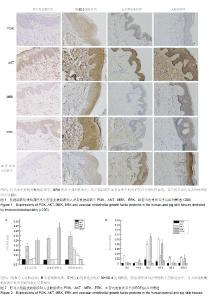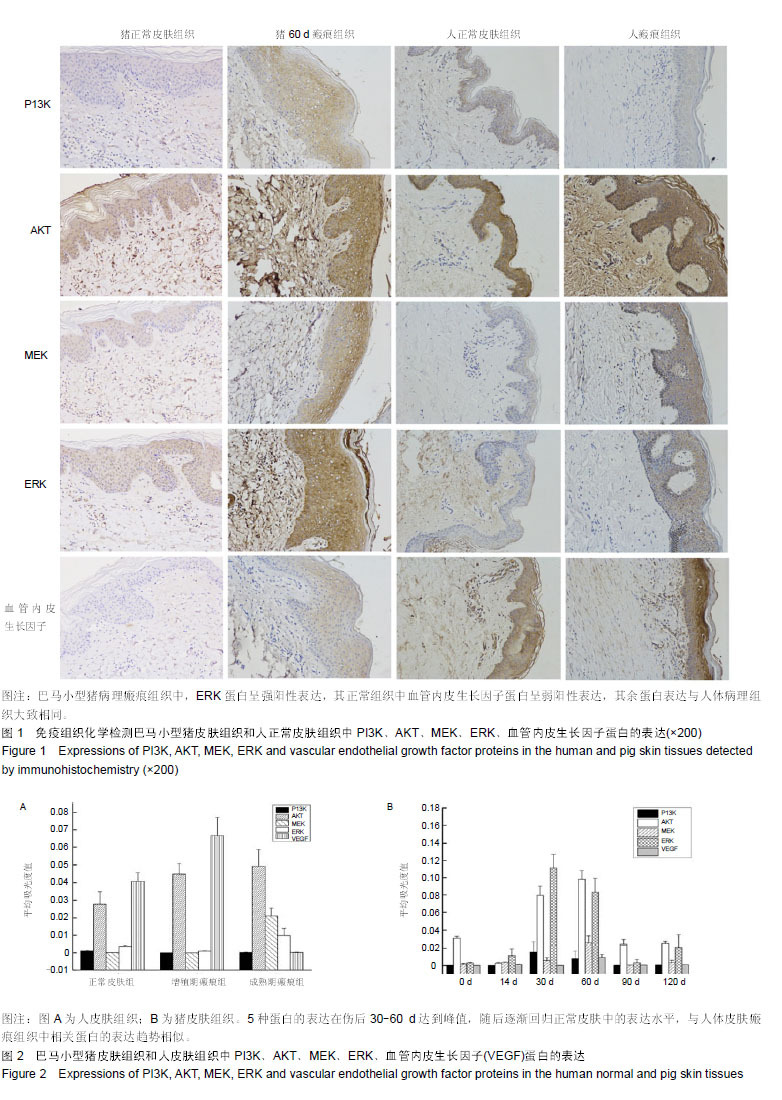Chinese Journal of Tissue Engineering Research ›› 2019, Vol. 23 ›› Issue (23): 3673-3679.doi: 10.3969/j.issn.2095-4344.1312
Previous Articles Next Articles
Trend similarity of PI3K/AKT and MEK/ERK signaling pathways related protein expression in the hypertrophic scar of Bama pigs and human
Li Chenchen1, 2, Liu Baimei1, 2, Liu Yang1, 2, Lü Ying1, 2, Cui Pudong1, 2, An Meiwen1, 2
- (1Institute of Applied Mechanics and Biomedical Engineering, Taiyuan University of Technology, Taiyuan 030024, Shanxi Province, China; 2Shanxi Provincial Key Laboratory of Material Strength and Structural Impact, Taiyuan 030024, Shanxi Province, China)
-
Received:2019-02-16Online:2019-08-18Published:2019-08-18 -
Contact:An Meiwen, PhD, Professor, Institute of Applied Mechanics and Biomedical Engineering, Taiyuan University of Technology, Taiyuan 030024, Shanxi Province, China; Shanxi Provincial -
About author:Li Chenchen, Master candidate, Institute of Applied Mechanics and Biomedical Engineering, Taiyuan University of Technology, Taiyuan 030024, Shanxi Province, China; Shanxi Provincial Key Laboratory of Material Strength and Structural Impact, Taiyuan 030024, Shanxi Province, China -
Supported by:the National Natural Science Foundation of China, No. 11372208 and 31870934 (both to AMW)
CLC Number:
Cite this article
Li Chenchen1, 2, Liu Baimei1, 2, Liu Yang1, 2, Lü Ying1, 2, Cui Pudong1, 2, An Meiwen1, 2 . Trend similarity of PI3K/AKT and MEK/ERK signaling pathways related protein expression in the hypertrophic scar of Bama pigs and human [J]. Chinese Journal of Tissue Engineering Research, 2019, 23(23): 3673-3679.
share this article

2.1 巴马小型猪皮肤组织和人正常皮肤组织免疫组织化学观察 目标蛋白阳性表达信号呈棕黄色颗粒状,并且主要表达于细胞质中。在人体正常皮肤组织中,PI3K/AKT蛋白在表皮层呈阳性表达,在真皮层呈弱阳性表达;MEK蛋白在真皮层中呈阴性表达,ERK蛋白在真皮层中呈弱阳性表达,两者在表皮组织中表达较低;在病理组织中,AKT蛋白呈强阳性表达;MEK蛋白在真皮层中表达较正常组增强,MEK/ERK蛋白在表皮层表达较正常组也明显增强。血管内皮生长因子蛋白在正常皮肤组织及病理组织中均呈阳性表达。在巴马小型猪正常皮肤组织中,血管内皮生长因子蛋白呈弱阳性表达,其余各蛋白的表达定位与人体正常皮肤组织相似;在病理瘢痕组织中,ERK蛋白呈强阳性表达,其余表达情况与人体病理组织大致相同。见图1。 2.2 巴马小型猪模型和人体皮肤组织PI3K/AKT蛋白表达 见图2。 2.2.1 巴马小型猪模型 PI3K的平均A值在取皮后30 d和60 d的皮肤组织中略高于0 d组(P30=0.007;P60=0.112),在取皮后90 d及120 d则逐渐下降回归至0 d组水平(P90 > 0.05;P120 > 0.05);对于其下游因子AKT,取皮后14 d,平均A值显著低于0 d组(P14=0.01);取皮后30 d和60 d的组织中平均A值则显著高于0 d组和14 d组(P30=0.000,P60=0.000),60 d组略高于30 d组;取皮后90 d及120 d,AKT的平均A值变化规律与PI3K一致(P90 > 0.05;P120 > 0.05)。 2.2.2 人体皮肤组织 病理增殖期瘢痕组、成熟期瘢痕组PI3K的平均A值均显著高于正常组(P=0.003,P=0.007),但增殖期瘢痕组、成熟期瘢痕组2组间差异无显著性意义 (P > 0.05)。病理增殖期瘢痕组、成熟期瘢痕组的AKT的平均A值同样高于正常组(P=0.033,P=0.013)。 2.3 巴马小型猪模型和人体皮肤组织MEK/ERK蛋白表达 见图2。 2.3.1 巴马小型猪模型 MEK的平均A值在取皮后60 d皮肤组织中高于0 d组及其余各时间点组(P=0.000),其余几组与0 d组相比较差异无显著性意义(P > 0.05);ERK的平均A值随时间依次增高,并在取皮后30 d达到最高(P30=0.000),直到取皮后60 d时ERK的平均A值依然显著高于其余各组(P60=0.003),但略低于30 d组;取皮后60 d后ERK的平均A值与对照组比较差异无显著性意义(P90 > 0.05;P120 > 0.05)。 2.3.2 人体皮肤组织 成熟期瘢痕组MEK/ERK的平均A值明显高于其余2组(PMC=0.000;PEC=0.019),正常皮肤组、增殖期瘢痕组间2种蛋白的平均A值比较差异无显著性意义(P > 0.05)。 2.4 血管内皮生长因子蛋白表达 2.4.1 巴马小型猪模型 血管内皮生长因子的平均A值在取皮后60 d显著高于对照组(P=0.000),其余时间点平均A值相比差异无显著性意义(P > 0.05)。 2.4.2 人体皮肤组织 增殖期瘢痕组血管内皮生长因子的平均A值较正常皮肤组显著升高(P=0.003),成熟期瘢痕组则显著低于正常皮肤组(P=0.000)。见图2。"

| [1]Kwan PO, Tredget EE. Biological Principles of Scar and Contracture. Hand Clin. 2017;33(2):277-292.[2]Alster TS,Tanzi EL.Hypertrophic scars and keloids: etiology and management. Am J Clin Dermatol.2003; 4(4):235-243.[3]Butzelaar L, Ulrich MMW, Mink vd MAB, et al.Currently known risk factors for hypertrophic skin scarring: A review. J Plast Reconstr Aes.2016; 69(2):163-169.[4]Butzelaar L, Soykan EA, Garre F, et al. Going into surgery: Risk factors for hypertrophic scarring. Wound Repair Regen. 2015; 23(4):531-537.[5]Matheny RW,Adamo ML.Current Perspectives on Akt Akt-ivation and Akt-ions.Exp Biol Med.2009; 234(11): 1264-1270.[6]Patel P, Sekiguchi Y, Oh KH, et al. Smad3-dependent and -independent pathways are involved in peritoneal membrane injury. Kidney Int.2010;77(4):319-328.[7]Baimei L, Yang L, Li W, et al. RNA-seq-based analysis of the hypertrophic scarring with and without pressure therapy in a Bama minipig model. Sci Rep-UK.2018; 8(1): 11831-11841.[8]农晓琳,邓凌,李佳荃,等. bFGF、TGFβ1在人皮肤病理性瘢痕不同时期的表达及意义[J].广西医科大学学报, 2010, 27(2): 180-183.[9]周鹏军,王琼,李张军,等. 光动力疗法对兔耳增生性瘢痕组织中MMP-9,MMP-13和TIMP-1的影响[J].中国皮肤性病学杂志, 2013,27(9):877-880.[10]蔡景龙.现代瘢痕学[M]. 北京:人民卫生出版社,1999.[11]Deitch EA, Wheelahan TM, Rose MP, et al. Hypertrophic burn scars: analysis of variables. J Trauma.1983;23(10): 895-898.[12]Beldon P. Abnormal scar formation in wound healing. Nursing Times.2000;96(10):44-45.[13]Bayat A, McGrouther DA, Ferguson MW. Skin scarring. Brit Med J.2003;326(7380): 88-92.[14]Kwan PO, Tredget EE. Biological principles of scar and contracture. Hand Clinics.2017; 33(2): 277-292.[15]Slemp AE, Kirschner RE. Keloids and scars: a review of keloids and scars, their pathogenesis, risk factors, and management. Curr Opin Pediatr.2006;18(4): 396-402.[16]Niessen FB, Spauwen PH, Schalkwijk J, et al. On the nature of hypertrophic scars and keloids: a review [J]. Plast Reconstr Surg.1999; 104(5): 1435-1458.[17]Ehrlich HP, Desmoulière A, Diegelmann RF, et al. Morphological and immunochemical differences between keloid and hypertrophic scar. Am J Pathol.1994;145(1): 105-113.[18]Schneider M, Meites E, Daane SP. Keloids: Which treatment is best for your patient?.J Fam Practice. 2013; 62(5):227-33.[19]南美兰,金哲虎,金承龙.4-HPR对瘢痕疙瘩成纤维细胞ProcollagenⅠ、MMP-1及信号通路P13K/Akt的影响[J].中国皮肤性病学杂志, 2018,32(3):245-251.[20]Jalali M, Bayat A.Current use of steroids in management of abnormal raised skin scars.Am Surgeon.2007; 5(3):175-180.[21]Leventhal D, Furr M, Reiter D. Treatment of Keloids and Hypertrophic Scars: A Meta-analysis and Review of the Literature. Arch Facial Plast Surg.2006; 8(6):362-368.[22]李荟元,鲁开化,郭树忠.新编瘢痕学[M].西安:第四军医大学出版社, 2003.[23]van der Veer WM, Bloemen MC, Ulrich MM, et al. Potential cellular and molecular causes of hypertrophic scar formation. Burns, 2009, 35(1):15-29.[24]王配合. γδT细胞、IGF-1及Akt与增生性瘢痕相关研究[D]. 石家庄:河北医科大学,2011.[25]陈伟,付小兵,孙同柱,等.增生性瘢痕中磷酸化 P38 丝裂原活化蛋白激酶和 c-Jun蛋白的表达特征及其与瘢痕形成的关系[J].中国修复重建外科杂志, 2003, 17(5):379-381.[26]Lin N, Moroi Y, Uchi H, et al. Significance of the expression of phosphorylated-STAT3, -Akt, and -ERK1/2 in several tumors of the epidermis. J Dermatol Sci.2007;48(1):71-73.[27]刘剑毅,李世荣. PI3K/AKT 信号通路在CTGF促人增生性瘢痕成纤维细胞转分化中的作用[J].中国美容医学杂志, 2008, 17(3): 395-397.[28]Paterno J, Vial IN, Wong VW, et al. Akt-mediated mechanotransduction in murine fibroblasts during hypertrophic scar formation. Wound Repair Regen, 2011, 19(1): 49-58.[29]An G,Liang SZ,Sheng CH,et al.Upregulation of microRNA-205 suppresses vascular endothelial growth factor expression-mediated PI3K/Akt signaling transduction in human keloid fibroblasts. Eep Biol Med.2017;242(3):1-11.[30]Lee JP, Li YC, Chen HY, et al. Protective effects of luteolin against lipopolysaccharide-induced acute lung injury involves inhibition of MEK/ERK and PI3K/Akt pathways in neutrophils.Acta Pharmacologica Sinica.2010; 31(7):831-838.[31]Hu XL, Wang HT, Liu JQ, et al. The role of ERK and JNK signaling in connective tissue growth factor induced extracellular matrix protein production and scar formation. Arch Dermatol Res.2013; 305(5):433-445.[32]Lee SJ,Namkoong S,Kim YM,et al.Fractalkine stimulates angiogenesis by activating the Raf/MEK/ERK-and PI3K/Akt/eNOS-dependent signal pathways .AmJ Physiol Heart Circ Physiol.2006;291(6):2836-2846[33]Bullard LE,Qi X,Penn JS. Role for extracellular signal-responsive kinase -1 and -2 in retinal angiogenesis. Invest Ophthalmol Vis Sci.2003; 44(4):1722-1731.[34]任萱,林莉萍,丁健.微管抑制剂C9抑制新生血管生成的作用机制[J].中国新药杂志, 2011,20(17):1703-1710[35]王芳,唐旭华,周晖. 分子靶向抗肿瘤药物的皮肤不良反应及处理[J]. 中华皮肤科杂志,2016,49(7):519-523.[36]Shetlar MR, Shetlar CL, Hendricks L, et al. The use of athymic nude mice for the study of human keloids. Exp Biol Med.1985; 179(4): 549-552.[37]Kischer CW, Pindur J, Shetlar MR, et al. Implants of hypertrophic scars and keloids into the nude (athymic) mouse: viability and morphology. J Trauma.1989; 29(5): 672-677.[38]Morris DE, Wu L, Zhao LL, et al. Acute and chronic animal models for excessive dermal scarring: quantitative studies. Plast Reconstr Surg.1997;100(3): 674-681.[39]李荟元,刘建波,兰海.建立增生性瘢痕动物实验模型[J].第四军医大学学报, 1998,19: 655-657.[40]李荟元,刘建波,夏炜,等.增生性瘢痕动物实验模型的建立与应用[J].中华整形外科杂志, 2001,17(5):276-278.[41]陈俊颖. 人与巴马香猪皮肤的比较生物学研究[J].中国比较医学杂志,2006,16(5):288-290.[42]Mitra A, Leyes A, Manser K, et al. Use of Minipig Skin Biopsy Model as an Innovative Tool to Design Topical Formulation to Achieve Desired Pharmacokinetics in Humans. J Pharm Sci-US.2015; 104(5):1701-1708.[43]Bai X, He T, Liu J, et al. Loureirin B inhibits fibroblast proliferation and extracellular matrix deposition in hypertrophic scar via TGF-\r, β\r, /Smad pathway. Exp Dermatol.2015; 24(5):355-360.[44]马娜,郭瑞珍,阮媛,等.PI3K-AKT-Bcl-2抗凋亡途径与瘢痕癌癌细胞凋亡相关性探讨[J].中华肿瘤防治杂志, 2014, 21(8):599-604.[45]李菲菲,米立国,隋鸿锦.血管内皮生长因子对皮肤血管生成影响的研究进展[J].大连医科大学学报,2009, 31(5):599-603.[46]行敏,赵凤梅,吴洁,等. CO2点阵激光联合紫草治疗增生性瘢痕临床疗效及对血清中VEGF的影响[J].中国皮肤性病学杂志, 2018,32(1):110-114.[47]李学锋,李道萍,王慧君. 小鼠皮肤创伤愈合过程中VEGF、TGF-β1、bFGF表达的免疫组织化学研究[J]. 中国组织化学与细胞化学杂志, 2003,12(4):367-371.[48]Bao P, Kodra A, Tomic-Canic M, et al. The Role of Vascular Endothelial Growth Factor in Wound Healing. J Surg Res. 2009;153(2):347-358[49]Labler L,Rancan M,Mica L,et al.Vacuum-assisted closure therapy increases local interleukin-8 and vascular endothelial growth factor levels in traumatic wounds.J Trauma Nurs.2009; 66(66): 749-757[50]Erba P, Ogawa R, Ackermann M, et al. Angiogenesis in wounds treated by microdeformational wound therapy. Ann Surg.2011; 253(2): 402-409.[51]Zhu KQ, Engrav LH, Armendariz R, et al. Changes in VEGF and nitric oxide after deep dermal injury in the female, red Duroc pig—further similarities between female, Duroc scar and human hypertrophic scar. Burns.2005; 31(1):0-10.[52]刘晓彤,沈若武,卞明心,等.大鼠创伤皮肤组织VEGF、PDGF和bFGF表达及意义[J].青岛大学医学院学报, 2016,52(2): 209-211. |
| [1] | Hou Jingying, Yu Menglei, Guo Tianzhu, Long Huibao, Wu Hao. Hypoxia preconditioning promotes bone marrow mesenchymal stem cells survival and vascularization through the activation of HIF-1α/MALAT1/VEGFA pathway [J]. Chinese Journal of Tissue Engineering Research, 2021, 25(7): 985-990. |
| [2] | Bi Sheng, Sheng Baoying, Han Feng, Jiang Yaojia, Li Congyan, Tian Jiaying. Hypoxia-inducible factor 1 alpha is involved in brain injury/protection in rats with acute cerebral infarction [J]. Chinese Journal of Tissue Engineering Research, 2021, 25(35): 5644-5649. |
| [3] | Lou Pengqiang, Wei Wei, Hou Decai. Evaluation methods of animal models of femoral head necrosis: merits and demerits [J]. Chinese Journal of Tissue Engineering Research, 2021, 25(32): 5210-5214. |
| [4] | Tang Shuo, Hou Decai. Constructing an animal model of femoral head necrosis: how to get closer to clinical application [J]. Chinese Journal of Tissue Engineering Research, 2021, 25(29): 4691-4696. |
| [5] | Cheng Ning, Zhang Zhizhong. Regulatory effects of LncRNA MEG3 on the proliferation and apoptosis of nucleus pulposus cells in rat intervertebral disc [J]. Chinese Journal of Tissue Engineering Research, 2021, 25(26): 4106-4111. |
| [6] | Yang Li, Li Xueli, Song Jinghui, Yu Huiqian, Wang Weixia. Effect of cryptotanshinone on hypertrophic scar of rabbit ear and its related mechanism [J]. Chinese Journal of Tissue Engineering Research, 2021, 25(20): 3150-3155. |
| [7] | Chen Yutong, Li Chenchen, Liu Yang, Zheng Yaqin, Yang Xihua, An Meiwen. Establishment of an acute radioactive skin injury model in Wistar rats [J]. Chinese Journal of Tissue Engineering Research, 2021, 25(2): 237-241. |
| [8] | Wang Yan, Dong Benchao, Wang Ying, Sun Lei, Lu Bin, Bai Haohao, Tian Aixian, Ma Jianxiong, Ma Xinlong. Animal models of osteonecrosis of the femoral head: modeling methods and characteristics [J]. Chinese Journal of Tissue Engineering Research, 2021, 25(2): 292-297. |
| [9] | Ma Dujun, Peng Liping, Chen Feng, Jiang Shunwan, Jiang Jinting, Gao Kun, Lin Zhanpeng. Research strategy of gene editing technology in the gene treatment of osteoarthritis [J]. Chinese Journal of Tissue Engineering Research, 2021, 25(2): 298-303. |
| [10] | Liu Hong, Wan Zhe, Zhang Zhen, Zhang Qin. Relationship between root resorption and intrusive force during maxillary molar intrusion in Beagle dogs [J]. Chinese Journal of Tissue Engineering Research, 2021, 25(14): 2172-2176. |
| [11] | Mo Caifeng, Cheng Xiaoyang, Liao Ming, He Dongling, Huang Zhi. A Guangxi Bama minipig model of Trimeresurus stejnegeri snakebite: modeling and evaluation [J]. Chinese Journal of Tissue Engineering Research, 2021, 25(11): 1688-1692. |
| [12] | Ruan Guangping, Yao Xiang, Cai Xuemin, Li Zian, Pang Rongqing, Pan Xinghua. Effect of umbilical cord mesenchymal stem cell transplantation for treating systemic lupus erythematosus in a tree shrew model [J]. Chinese Journal of Tissue Engineering Research, 2021, 25(1): 90-95. |
| [13] | Cao Guolong, Tian Faming, Liu Jiayin. Lovastatin combined with insulin effects on fracture healing in rat models of bilateral ovariectomized type 2 diabetic mellitus [J]. Chinese Journal of Tissue Engineering Research, 2020, 24(5): 673-681. |
| [14] | Wang Jing, Lu Changfeng, Peng Jiang, Zhu Chen, Xu Wenjing, Cheng Xiaoqing, Fang Jie, Zhu Yaqiong, Zhao Yanxu, Jiang Wen, Xu Hongguang, Wang Yu. Establishment and evaluation of traumatic neuroma model [J]. Chinese Journal of Tissue Engineering Research, 2020, 24(5): 716-719. |
| [15] | Zhang Shiyong, Wang Chengwei, Wang Xue, Yan Xiangli, Wang Jie. Application of digital subtraction angiography in dog hindlimb arteriography [J]. Chinese Journal of Tissue Engineering Research, 2020, 24(5): 704-708. |
| Viewed | ||||||
|
Full text |
|
|||||
|
Abstract |
|
|||||